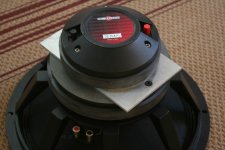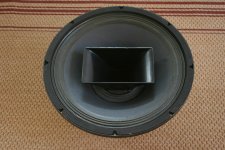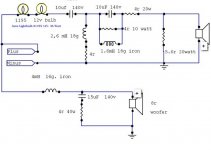I am needing some understanding on this crossover provided for me to use on these custom B&C coax speakers that i bought second hand. Using this crossover, they do work quite nicely and do sound really nice even though i dont think they are design for them (schematics is really for B&C coax 15hcx76)
1.) what is the 4ohm resistor in series after the 15uf in the woofer network for and do i need to have that there. I currently install the crossover without it as i dont really have any 4ohm 40watt resistor.
2.) The 4 ohm in series and 5.6ohm in parallel to the tweeter at end - is that acting like lpad. Using the lpad calculator, i tried all scenarios from 6db to 12db and don't see any case that would use 4ohm and 5.6ohm.
I perceive that on this setup the tweeter does sound slightly louder than the woofer and want to adjust these resistors to make it 1 or 2db less - how would i do this without actually install a Lpad. Using the lpad calculator to attenuate
9db, i would need 5.16ohm ad 4.4ohm resistors; 10db would need 5.47ohm 3.7ohm resistors. Would i mess up the design if i alter the value of the resistors in the schematics.
Thank you in advance.
1.) what is the 4ohm resistor in series after the 15uf in the woofer network for and do i need to have that there. I currently install the crossover without it as i dont really have any 4ohm 40watt resistor.
2.) The 4 ohm in series and 5.6ohm in parallel to the tweeter at end - is that acting like lpad. Using the lpad calculator, i tried all scenarios from 6db to 12db and don't see any case that would use 4ohm and 5.6ohm.
I perceive that on this setup the tweeter does sound slightly louder than the woofer and want to adjust these resistors to make it 1 or 2db less - how would i do this without actually install a Lpad. Using the lpad calculator to attenuate
9db, i would need 5.16ohm ad 4.4ohm resistors; 10db would need 5.47ohm 3.7ohm resistors. Would i mess up the design if i alter the value of the resistors in the schematics.
Thank you in advance.
Attachments
It's not a "no no" to mix nominal impedances as long as the crossover is correct for them, but aren't these both 8Ω? Anyway, the 4Ω resistor in series with the woofer cap would change the slope and phase quite significantly. It's there for a reason, but if you're not using the intended drivers...
Same with the HF resistors: yes it will mess it up to mess with them, but you're not using the drivers it was designed for anyway, so presumably it already isn't working as designed.
Same with the HF resistors: yes it will mess it up to mess with them, but you're not using the drivers it was designed for anyway, so presumably it already isn't working as designed.
It's not a "no no" to mix nominal impedances as long as the crossover is correct for them, but aren't these both 8Ω? Anyway, the 4Ω resistor in series with the woofer cap would change the slope and phase quite significantly. It's there for a reason, but if you're not using the intended drivers...
Same with the HF resistors: yes it will mess it up to mess with them, but you're not using the drivers it was designed for anyway, so presumably it already isn't working as designed.
Yes, the woofers and tweeters are both 8ohm. As mentioned it sound fine even though schematics was not designed for...
The 4ohm resistor in series with the woofer --> is this for 8ohm driver?
same question for the HF resistor. Thanks.
1.) what is the 4ohm resistor in series after the 15uf in the woofer network for and do i need to have that there. I currently install the crossover without it as i dont really have any 4ohm 40watt resistor.
That's to flatten the impedance of the woofer. In other words, to make the woofer more "Resistive" than "Reactive". I would suggest you have that installed. The woofer is a 1st order. Without this impedance eq network, there's a good chance the woofer breakup will affect the mids.
If you can't get hold of 40W resistors, you can parallel 2 pieces of 8 or 8.2 ohms 20W. This will give you 4 ohms/40W.
Yes it is a L-pad.2.) The 4 ohm in series and 5.6ohm in parallel to the tweeter at end - is that acting like lpad.
I perceive that on this setup the tweeter does sound slightly louder than the woofer and want to adjust these resistors to make it 1 or 2db less - how would i do this without actually install a Lpad.
Since the crossover "work quite nicely and do sound really nice", I suggest leaving it alone. Do not change the resistors in the L-pad. To reduce the loudness of the tweeter, all you have to do is to install a resistor between the two light bulbs and the 10uF. Start off with a value like 2.2 ohms. If it is still too loud, increase it to 3.3 ohms and so forth. You can use 5W for the time being. Once you settle on the right value, you can then replace it with a 20W or more.
Regards
Mike
The circuit in parallel with the woofer it's a Zobel or woofer damper.
To attenuate more the tweeter L-pad R1/R2 (4R/5.6R) atten.~7dB as you are asking, use approx. resistors. A good place to start it's (resistors values R1/R2) for approxim. ~10dBs, R1=4.7/R2=3.3 or R1=6.8/R2=4.7 to R1=10/R2=6.8 then check if you need more or less. ex:
For target atten.8dB (4.34/4.6 R) = for R1: 4.0 or 4.5, 4.70 / for R2: 4.5, 4.70, 5.0
target atten.9dB (4.65/3.83 R) = for R1: 4.70 or 5.0 / for R2: 3.5, 3.9, 4.0
target atten.10dB (4.92/3.23 R) = for R1: 4.70, 5.0/ for R2: 2.7, 3.0, 3.3
Try testing what resistors you need, before you buy the more quality non inductive expensive ones. You can also test with a variable L-Pad and measured for it's resistiveness for approximation of the attenuation needed (for both resistors value in series and parallel). The inductance of all the drivers are variable not fixed (like 8R nominal for this CD), represented more like a curve not a graph straight line.
L pad calculator - attenuation dB damping impedance decibel loudspeaker speaker voltage divider - sengpielaudio Sengpiel Berlin
Resistors for Speakers
To attenuate more the tweeter L-pad R1/R2 (4R/5.6R) atten.~7dB as you are asking, use approx. resistors. A good place to start it's (resistors values R1/R2) for approxim. ~10dBs, R1=4.7/R2=3.3 or R1=6.8/R2=4.7 to R1=10/R2=6.8 then check if you need more or less. ex:
For target atten.8dB (4.34/4.6 R) = for R1: 4.0 or 4.5, 4.70 / for R2: 4.5, 4.70, 5.0
target atten.9dB (4.65/3.83 R) = for R1: 4.70 or 5.0 / for R2: 3.5, 3.9, 4.0
target atten.10dB (4.92/3.23 R) = for R1: 4.70, 5.0/ for R2: 2.7, 3.0, 3.3
Try testing what resistors you need, before you buy the more quality non inductive expensive ones. You can also test with a variable L-Pad and measured for it's resistiveness for approximation of the attenuation needed (for both resistors value in series and parallel). The inductance of all the drivers are variable not fixed (like 8R nominal for this CD), represented more like a curve not a graph straight line.
L pad calculator - attenuation dB damping impedance decibel loudspeaker speaker voltage divider - sengpielaudio Sengpiel Berlin
Resistors for Speakers
Last edited:
Yes that is an L pad. As an aside, mixing a 4 ohm speaker with an 8 ohm one is a no no.
Mac
Sorry, for some reason I thought the tweeter was 4 ohm.
@Dumptruck: Sorry to say but a 4 ohm speaker and an 8 ohm speaker will mess the crossover around, any good reference will tell you that.
p.s don't forget to take the woofer inductor resistance into account when calculating L-pad values.
Last edited:
Any "good reference" might tell you not to put a 4Ω woofer on a textbook 8Ω crossover, but a textbook crossover won't work right with most drivers regardless. Designing a crossover intended for drivers of different impedances is no problem at all.@Dumptruck: Sorry to say but a 4 ohm speaker and an 8 ohm speaker will mess the crossover around, any good reference will tell you that.
- Status
- This old topic is closed. If you want to reopen this topic, contact a moderator using the "Report Post" button.
- Home
- Loudspeakers
- Multi-Way
- Crossover help


